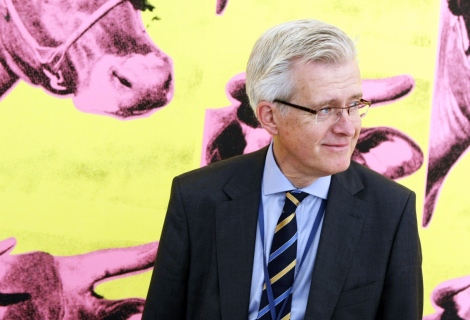“The devil is in the details”
112 meetings in 135 days with more than 20 000 delegates in over 65 different venues in 26 towns all over Sweden. The Presidency has been a real challenge for the Swedish meetings secretariat and its Head, Mårten Grunditz. Now he looks back on the past six months with both relief and joy.

Photo: Gunnar Seijbold/Regeringskansliet
Mårten Grunditz, Head of the Swedish meetings secretariat at the Museum of Modern Art in Stockholm, ahead of the informal meeting of foreign ministers on 4–5 September.
“The number of meetings and locations, the variables of each meeting and a tight budget have made for a difficult equation. But thanks to good planning, reliable suppliers and competent staff, we have managed to stay the course”, he says.
During his years as Head of the European Union Department at the Ministry for Foreign Affairs, Mårten Grunditz has participated in many EU meetings. But he has never before worked with the logistics behind the meetings.
“If you are a delegate concentrating on the substance of a meeting, it is hard to comprehend how many logistical details that must be in place at a well-functioning international meeting. And the devil is in the details. We have therefore been very careful to preach that everyone working in the field at a meeting has a responsibility both for the whole picture and the details”, says Mr Grunditz.
Many meetings and tight budget
One great challenge has been the number of meetings but also the placement of meetings in locations and at times not controlled by the secretariat. Another challenge has been the financial framework with a budget of SEK 421 million (approx. EUR 40 million).
“Some of our foreign colleagues could hardly believe us when we told them about our budget. But with centralised procurement, scheduling 35 meetings at the same conference facility and with ministerial meetings taking place back-to-back, we seem to have managed”, says Mårten Grunditz.
“The meetings will move the EU’s agenda forward”
The secretariat has received many positive comments from journalists and foreign delegates. The meetings have been perceived as being well organised, pleasant and attractive. Members of the media have appreciated the technology and the transparency, for example in the system of mixed zones which was used at many of the meetings.
Well-oiled machinery and punctual – is there no risk that we are confirming the image of Swedes as boring and predictable?
“Surely, delegates are not attending the meetings in order to party? The meetings are part of a political process. They should move the EU’s agenda forward and add new aspects to it. But with the limited time at our disposal, we have served up glimpses of Sweden as a modern nation, as a culinary nation and as a country with beautiful nature and culture”, he says.
“Planning and risk analysis gave us a sense of security”
The planning began in January 2008. Just before the Presidency took off, the secretariat presented an extensive risk analysis of what could go wrong and drew up proposed measures.
“Fortunately, there have been no major incidents, no vandalism or even loss of personnel due to the new influenza, but it has given us a sense of security knowing that we have plans for all such contingencies and many other things that could go wrong”, says Mårten Grunditz.
The lengthy planning period and the risk analysis gave us great confidence from the very beginning. Staff have been told by some delegates that they look strangely calm.
“This is probably also due to us preaching the importance of at least looking calm and controlled. An organiser running wild-eyed through the corridors hardly inspires confidence”, says Mr Grunditz.
Published
30 December15:20
Council
European Council (not council-specific)
Location
Stockholm, Sweden


